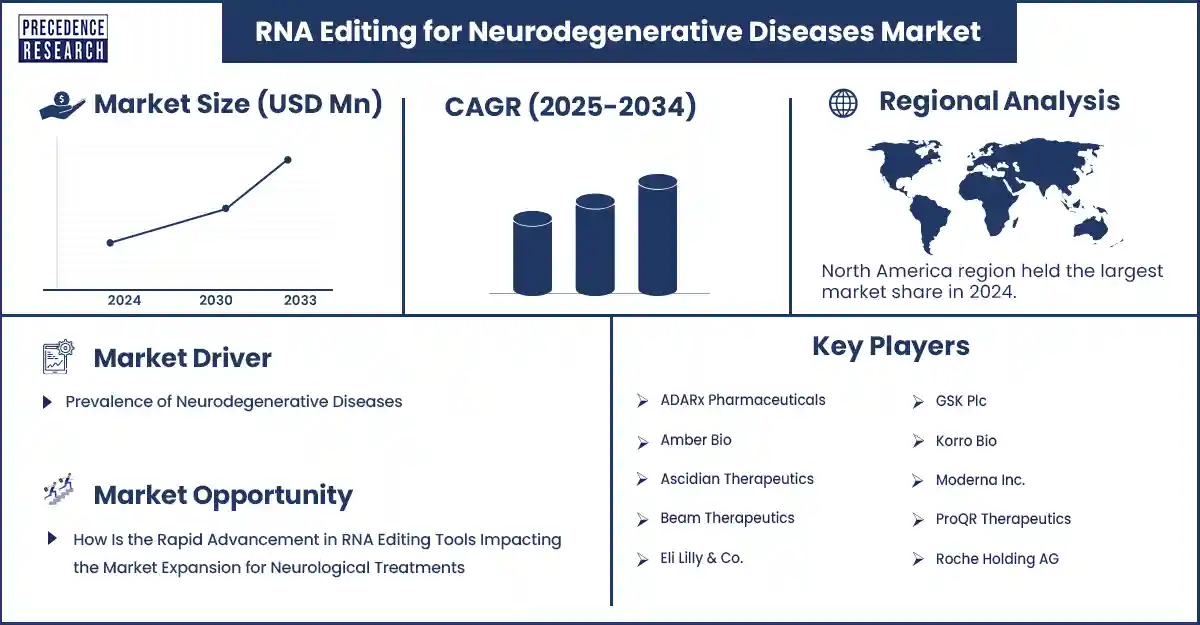RNA Editing for Neurodegenerative Diseases Market Revenue and Forecast by 2033
RNA Editing for Neurodegenerative Diseases Market Revenue and Trends 2025 to 2033
The global RNA editing for neurodegenerative diseases market innovation accelerates development of treatments for complex neurodegenerative conditions. The RNA editing for neurodegenerative diseases market encompasses therapies that modify RNA sequences to correct disease-causing mutations or regulate gene expression in conditions such as Alzheimer's and Parkinson's disease. This market is propelled by advancements in understanding and technology for modulating RNA, particularly A-to-I editing via ADAR enzymes and CRISPR-based tools.

Key drivers enabling the growth of the RNA Editing for Neurodegenerative Diseases Market
Several factors are driving the growth of the RNA editing market for neurodegenerative diseases, including the rising prevalence of these disorders within aging populations and the pressing need for more effective treatments. Notable advancements in technologies like ADAR-mediated and CRISPR-based RNA editing, along with significant investments from pharmaceutical and biotech companies, are fueling this growth. Additionally, expanding research and development activities, promising results from clinical trials, and driving therapeutic innovation.
Segment insights
- By editing modality/ mechanism, ADAR-mediated base editing is the most dominant approach, providing precise and reversible modifications to RNA. This offers therapeutic advantages over permanent DNA editing by avoiding off-target genomic changes.
- By target neurodegenerative diseases, the Alzheimer's disease (AD) segment held the largest share of the market. This is due to Alzheimer's being the most common neurodegenerative disorder, having a complex pathophysiology, and presenting broad therapeutic potential through RNA-based approaches.
- By delivery platform, AAV-based delivery led the market owing to its ability to efficiently deliver genetic material to the central nervous system with high specificity and relatively low immunogenicity.
- By product types, the synthetic oligonucleotide editor segment dominated the market because it directly targets RNA, modulates gene expression, and has proven successful with an FDA-approved therapy for spinal muscular atrophy.
- By administration mode, the intrathecal administration segment is the leader, as it bypasses the blood-brain barrier, allowing direct access to RNA therapeutics in the central nervous system.
- By therapeutic intent, the gene correction segment accounted for a significant market share due to its potential for providing permanent, long-lasting solutions by directly addressing the underlying genetic causes of diseases such as Huntington's, ALS, and Parkinson's.
- By end-user, biopharmaceutical companies led the market, as their approach allows for targeted and effective therapeutic strategies that cater to the specific needs of patient populations with conditions like ALS, Alzheimer's, and Parkinson's.
- By distribution channel, research collaboration supply chains dominated the market because they help overcome the significant challenges in delivering drugs to the central nervous system by refining nanocarrier and delivery technologies.
RNA Editing for Neurodegenerative Diseases Market Coverage
| Report Attribute | Key Statistics |
| Quantitative Units | Revenue in USD million/billion, Volume in units |
| Largest Market | North America |
| Base Year | 2024 |
| Regions Covered | North America, Europe, Asia-Pacific, Latin America, and Middle East & Africa |
Regional Insights
North America is the dominant region in the RNA editing market for neurodegenerative diseases. This growth is primarily driven by its advanced healthcare infrastructure, substantial investments in research and development, and favorable government and reimbursement policies. The U.S. and Canada have established regulatory frameworks that support the adoption of new, often high-cost therapies, benefiting from a large patient population, a concentration of leading biotechnology companies, and strong academic research institutions.
Asia-Pacific region is expected to see rapid growth in the RNA editing market for neurodegenerative diseases. This is mainly due to a combination of a large aging population with high disease prevalence, increasing healthcare demands, a growing patient population, significant government and biopharmaceutical investments in research, and the region's expanding expertise in biomanufacturing and clinical trials, creating a robust market for new therapies.
Recent Development
- In October 2024, Wave Life Sciences Ltd. announced positive proof-of-mechanism data from its ongoing Phase 1b/2a RestorAATion-2 study of WVE-006 for alpha-1 antitrypsin deficiency (AATD). WVE-006 is a GalNAc-conjugated, subcutaneously delivered A-to-I RNA editing oligonucleotide (AIMer) developed with Wave's best-in-class oligonucleotide chemistry platform to address AATD-related lung and liver diseases.(Source: https://ir.wavelifesciences.com)
RNA Editing for Neurodegenerative Diseases Market Key Players
- ADARx Pharmaceuticals
- Amber Bio
- Ascidian Therapeutics
- Beam Therapeutics
- Eli Lilly & Co.
- GSK Plc
- Korro Bio
- Moderna Inc.
- ProQR Therapeutics
- Roche Holding AG
- Shape Therapeutics
- Takeda Pharmaceutical Company
- Verve Therapeutics
- Wave Life Sciences
Get this report to explore global market size, share, CAGR, and trends, featuring detailed segmental analysis and an insightful competitive landscape overview @ https://www.precedenceresearch.com/sample/6771
You can place an order or ask any questions, please feel free to contact at sales@precedenceresearch.com |+1 804 441 9344